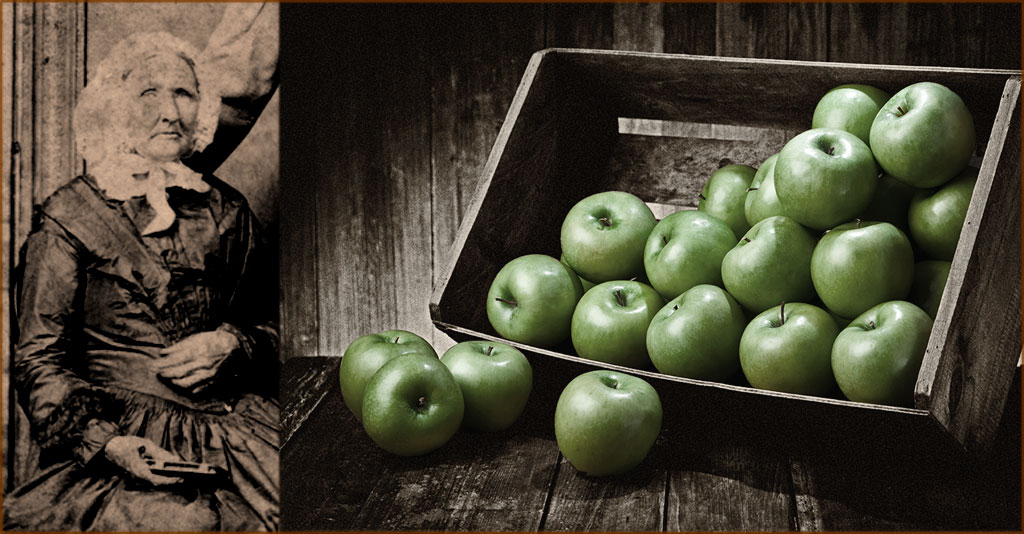You are currently browsing the tag archive for the ‘camaraderie’ tag.
Thick skin, leathery texture, meaty fruit, green color, tart flavor—Yes, it’s the Granny Smith apple, only appearing in American supermarkets beginning in the 1970s. The experience of crunching into this apple finds it in many shopping bags, the world over. Lowest in sugar of all the apples, it requires a cultivated taste to fully appreciate its gift. Once mastered, green apples grace pies, crisps, salads, sorbets, rolls, juice, dumplings and so much more, dependent upon the imagination of cooks.
But there’s another story about the Granny Smith apple that few know in our country. There really was such a Granny: her name was Maria Ann Sherwood Smith (1799 – 1870), an Australian orchardist who worked in fruit orchards, a trade she, her husband, and five children brought with them from economically strapped Sussex, England in 1839. A combination of hard work, study, camaraderie with other orchardists adjacent to their twenty-four acres, and their children’s willingness to learn the trade led to the Smiths’ simple prosperity.
Pie-baking was another skill that Granny excelled in, often taking home prizes from local fairs. When not working in the orchards, she could be seen by the kitchen window, tossing out seeds and stems from the fruit she was preparing for one of her concoctions. A twenty-five-foot creek close to their farm caught many of the scraps—site for their composting.
One morning in 1868, her practiced eye caught what appeared to be an unfamiliar seedling with green fruit growing near the creek; it resembled the crossing of a French crab-apple tree and an apple tree: the remarkable outcome of the scraps of her compost.
Maria Ann Smith was already a loving granny before her discovery of the green apple tree, so its naming after her was a given. Try one and learn to enjoy it.
I stood behind the storm door and waved handfuls of dollars to the ten-year-olds wearing aqua T-shirts, touting the message, Children ‘r’ For Us, against the backdrop of the St. Louis Arch, also stenciled in white—evidence of the kids’ week-long camp.
The milky sky seemed to energize their antics, grouped around their lemonade stand and waving down the few passing cars. Whatever their cause, they were solidly behind it.
It took a while before they noticed my opened door, and a black boy took the lead, his smile deepening the closer he came to my porch. Others grinned, hurried to keep up, curious, no doubt, of the amount in my hand. To my surprise, the black boy bowed from the waist, tented his palms, and said, “Namaste.” Other thanks followed. Someone even said, “God bless you.” Smiling eyes knew, somehow, yet, only a few of the kids were known to me.
Over the years, I’d contributed to other lemonade stands set up on the corner upon which my bungalow sits, but never received such gratitude like this afternoon’s. Whatever was going on, the parents of these kids knew what was essential: love, and they taught it well to their children, its surprise shimmering of an Unknown Presence.
“Just a little more—Easy—Just a little more—There! That’s it,” barked the seasoned supervisor, wearing hardhat and DayGlo vest, as he waved to the driver seated in the cab of the concrete mixer. As the drum ground to a halt, another workman power-hosed the trough before the next pour.
The ten-member crew from the woman-owned Sweetens Concrete Services had been working on our court for two weeks, the final phase of replacing a malfunctioning storm sewer. This afternoon’s work brought them to the front of my bungalow, and I had to watch.
The guys, also wearing rubber boots and other protective gear, knew exactly what to do. Some smoothed the wet concrete to the edges of long boards secured in the ground by spikes; some, with rakes, filled out the designated area; some moved long-handled placers, appearing like wide maintenance brooms, for further smoothing; some knelt by the curb and, with trowels, edgers, and groovers continued the smoothing.
After perhaps five minutes, the supervisor turned on the vibratory plate compactor and slowly swept it over the new concrete, giving it the appearance of the street next to it. More tweaking with long-handled brushes left striations on the surface to prevent falls when rain-soaked.
Significant lessons surfaced as I went indoors. More than evident were the crew’s precision, their practiced eye, and their hardened bodies; their camaraderie added brightness and color to the afternoon. But painfully as well was how I’d taken concrete streets and sidewalks for granted for my convenience, with no thought of the intensive labor involved to construct them.





